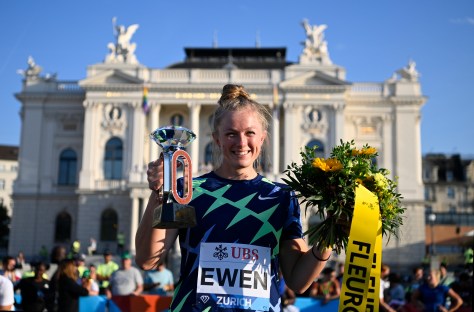
Remember that moment in Rocky when out of nowhere he decks Apollo Creed in the first round? Nobody in the place thinks he’ll so much as lay a glove on Creed,, and then…Bam!…he lands a haymaker. In the end, Rocky did not win the that fight, but that punch and his ability to hang tough for fifteen rounds against overwhelming odds gave him credibility as an athlete and changed the course of his career and his life.
Okay, I know Rocky is a movie. Don’t mistake me for those Game of Thrones fans who can’t wait for time travel to be invented so they can go back and get a look at a dragon.
But I witnessed a very Rocky-like moment in real life recently. It occurred, ironically enough, during the first round of the women’s shot at the USATF Championships in Des Moines.
As I sat down on that perfect Sunday afternoon to watch flight two warm-up, I anticipated a hard-fought battle between the current NCAA shot put champion Maggie Ewen and the defending USATF champion Raven Saunders.
I’d also hoped that Rio Olympic champ Michelle Carter would push the youngsters and make it a three-way contest, but it became clear during warm-ups that she was not in shape to do that. (Afterwards, Michelle revealed that that she was still recovering from off-season knee surgery.)
No other thrower seemed likely to break 18 meters, and since Ewen and Saunders were reliable 19-meter throwers, this was clearly going to be a two-person race.
It turned out, however, that I’d missed something during warm-ups, a clear sign that a third contestant might just upset the form chart.
Twenty-six-year-old Jessica Ramsey, who had finished fifth in the hammer competition a day earlier and who came to Des Moines with a lifetime best in the shot of 18.42m, had warmed up with several non-reverse throws, each of which had traveled around 17 meters.
As signs go, this was admittedly a subtle one.
According to the Bible, signs foreshadowing an earth shaking event may include “distress of nations in perplexity…the roaring of the sea and the waves, people fainting with fear and with foreboding.”
Nothing in there about fixed-feet fulls.
But to two people present in Drake Stadium that day, Ramsey and her coach John Smith, those warm-up throws portended a cosmic shift in the women’s shot.
Ramsey recalled later that those warm-up tosses “told me I was going to get it.”
Smith recalls seeing them and thinking, “Okay, here it comes.”
And come, it did.
Ramsey strode into the ring on her first throw and absolutely killed one.
“After warm-ups,” she recalled later, “I prayed and did my little meditation. Then, on that first throw when I hit the middle and I stayed in, I felt like it was a good one.”
It was. The throw measured 19.23m.
It was a three-foot PR and the seventh best throw in the world this year. In the space of a couple of seconds, Ramsey had gone from an anonymous member of a large group of better-than-average American female shot putters to one of the best in the world at her event.
Actually, it took a little longer than a couple of seconds.
Ramsey graduated from Western Kentucky University in 2014 having put together a fine college career (seven-time conference champion, all-American in the shot) under a fine college coach (Ashley Muffet, now at Ohio State). Her PRs though (53.84m in the disc, 61.44m in the hammer, and 17.49m in the shot) were not necessarily those of a future world-class thrower. Ewen, by comparison, just graduated from Arizona State having thrown 62.47m in the disc, 74.56m in the hammer, and 19.46m in the shot.
In spite of this, Ramsey was determined to pursue a career in the professional ranks, so she packed her belongings and relocated to Carbondale, Illinois, to train with Smith, at that time the throws coach at Southern Illinois University.
Two months after her arrival, Ramsey’s determination received its first test when Coach Smith and his wife Connie Price Smith accepted an offer to take over the track program at Ole Miss. Ramsey describes that moment as “very hard for me. I had just moved to Carbondale! I’d packed up everything and spent all my money to move there, and a couple of months later I had to pack up again.”
After settling in Oxford, Mississippi, Ramsey had to figure out how to support herself while also leaving time to train.
“When I first came to Mississippi, I worked at a senior care facility, a daycare facility, and a company called Insomnia Cookies. That kind of hindered my practicing.”
“Later, I got a raise at Insomnia, so I dropped the senior care job. After that, I got hired at Dicks Sporting Goods, so I dropped the daycare job. That’s where I’m at now. Most of the time, I work seven days a week just to pay the bills.”
In spite of this, under Smith’s tutelage Ramsey kept improving in the hammer and the shot.
As a glide shot putter, Ramsey could not have found a better, more experienced coach than Smith. Many years ago, Smith developed a reputation as the best glide shot coach in the United States. He honed his skills at teaching the glide while guiding Connie to a long and remarkably successful career that began in the 1980’s when winning international medals meant beating the Commies, and lasted until the early 2000’s by which time the fall of the Eastern Bloc and the advent of stricter drug testing protocols had significantly altered the nature of the sport.
Throughout most of Connie’s career, all evidence indicated that the glide technique was the most reliable path for a female shot putter to win a medal at a major championship.
It was not until Jill Camarena-Williams nabbed bronze at the 2011 Worlds that a rotational shot putter broke through. Prior to that, every World and Olympic medal awarded in the women’s shot had been won by a glider.
But the increasing success of the rotational technique among the men (including a sweep of shot medals at the 2000 Olympics) caused Smith to believe that women could benefit from adopting the rotational technique as well.
In March of 2014, shortly before Ramsey joined his training group, Smith posted an article in which he made a compelling case that it was time for female putters to abandon the glide.
So Ramsey was in for a bit of a surprise when she arrived in Oxford. Smith wanted to convert her to the spin.
She did not give in easily.
“The first year,” Smith told me a couple of days after the USATF meet, “she fought me on it. If the spin wasn’t working for her in practice, she’d go back to the glide.”
Ramsey has similar memories of that period. “I didn’t want to change because I was consistently throwing 58-59 feet with the glide, and when we tried the spin it was so hard! Some days I’d be like, ‘I got this!’ Then other days, I’d be slipping in the middle, fouling, dropping my elbow, and I’d think, ‘I’m going back to the glide!’ The thing about the spin is, if you miss one thing then the whole throw is messed up! That’s what’s frustrating about it. Even at meets, I’d sometimes start with the spin and then switch to the glide.”
Complicating matters was the fact that over her first two seasons with Smith, Ramsey pushed her glide PR into the 18-meter range. But Smith still felt that she was wasting her potential.
“She’s 5’6”, which is too small to be more than a sixty-foot glider. She’s explosive as hell, but her top end in the glide will never be what it is in the spin.”
Matters came to a head at the 2016 Olympic Trials.
“She didn’t throw worth a crap at the Trials,“ Smith recalled, “and a couple of days later at practice right there in Eugene, I said, ‘You need to change to the spin. I know for a fact from training people over the years that the spin is nine to nine-and-a-half percent better than the glide. If you add that on to your glide, you’re a sixty-six-footer!’”
Finally, a year ago, Ramsey committed fully to the rotational technique. Job one was to master the art of using the ground or, as Smith calls it, “working the Earth.”
Over many years of careful observation, Smith came to believe that gliders and non-reverse discus throwers shared a quality that was often missing from the technique of rotational putters: a strong connection with the ground. As he saw it, discus throwers and rotational putters who focused too much on getting air time–whether during the non-support phase or as they launched the implement from the power position–were sacrificing distance and reliability.
He discussed his theory in this article first posted in 2003. (Note: Check out Smith’s vision of the kind of rotational putter who might eventually threaten the men’s world record. It calls to mind a certain Sasquatch-sized Olympic record holder who was eleven years old at the time Smith wrote the article.)
Long story short, Smith made Ramsey take a whole lotta fixed-feet throws over the past year.
It all finally came together in Des Moines. After her huge throw, Ramsey felt the emotions welling but tried to hold them back. “I had to compose myself because I didn’t want it to look like I didn’t know I had a throw like that in me.”
She didn’t come close to 19 meters again (her series went 19.23m, 17.65m, 17.61m, F, 18.24m, F), and she didn’t win (Ewen passed her in round five with a toss of 19.29m) but that one throw was enough to get her an invitation to her first Diamond League meeting (in Rabat on July 13th) and perhaps usher in further life changes that will make staying in the upper echelon of putters a bit easier than getting there in the first place.
A strong showing in Rabat could get her invited to the Diamond League meeting in Monaco on July 19th. She is also scheduled to compete at the NACAC Championships in Toronto in early August.
If she finishes the year with a top-ten world ranking, Ramsey will likely qualify for the USATF tier system, which will allow her to have health insurance for the first time since leaving college.
Additionally, Ramsey hopes to soon be sponsored by the New York Athletic Club. Should that happen, she would be able to cut down to working only one job and have more time to recover from her daily training sessions.
Owing to the brutal financial calculus of the sport of track and field, Ramsey’s performance in this next handful of meets may determine whether or not her days of averaging five hours of sleep, of trying to get by on $300-$400 dollars worth of food per month, or praying that she doesn’t sustain an injury for which she cannot afford treatment, are over.
Either way, Ramsey is committed to continuing her journey.
“Confidence is the biggest thing in this track industry, and I’ve got it. I believe I am going to throw great in Rabat and that will open more doors for me.”
Not a bad attitude for a young athlete who wants nothing more out of life than a little extra free time that she can devote to mastering the fine art of “working the Earth.”
(You can find additional coverage of the USATF women’s shot competition including videotaped interviews with Jessica, Michelle, and Maggie here.)















